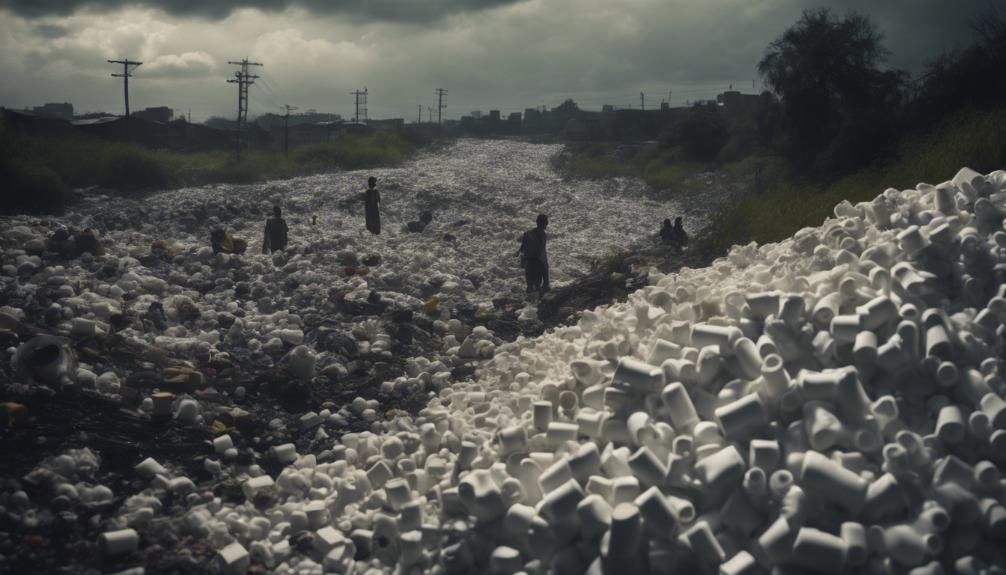Foam Lawsuits Surge Amid Cancer Fears
The recent surge in litigation concerning aqueous film-forming foam (AFFF) highlights a growing unease over its association with cancer and other health ailments, attributed to the presence of per- and polyfluoroalkyl substances (PFAS). These cases, now nearing 7,000 in multidistrict litigation, present a complex challenge for the legal system, manufacturers, and victims alike. As the scientific community and legal experts grapple with the implications of long-term exposure to these substances, one must consider the broader ramifications for public health policy, environmental protection, and corporate accountability. This unfolding scenario invites a closer examination of the intersection between law, ethics, and the pursuit of justice in an era of chemical ubiquity.

Key Takeaways
- AFFF lawsuits are nearing 7,000 cases, with plaintiffs alleging cancer from PFAS exposure.
- 3M and Dupont among manufacturers facing legal action over AFFF's health risks.
- Studies link AFFF exposure to cancers like testicular and kidney, fueling lawsuit claims.
- Legal battles focus on compensation for AFFF exposure victims, including medical costs and suffering.
Legal Updates Overview

The legal landscape surrounding Aqueous Film-Forming Foam (AFFF) lawsuits is rapidly evolving, with the Multi-District Litigation (MDL) nearing 7,000 cases amid rising concerns over cancer risks associated with PFAS exposure. As legal professionals dedicated to serving those affected by corporate negligence, it's crucial to stay informed about the MDL's progress. The increasing volume of lawsuits indicates a growing awareness and concern about the health impacts of PFAS chemicals. However, bankruptcy concerns loom large, with major defendants like 3M signaling financial strategies that could complicate plaintiffs' paths to justice. These developments underscore the urgency and complexity of the legal battle against PFAS contamination, highlighting the need for vigilant, compassionate legal advocacy to navigate the challenges ahead and seek accountability for those harmed.
AFFF Lawsuit Statistics

Building on the evolving legal landscape, it is essential to examine the quantitative aspect of AFFF lawsuits, notably the near 7,000 cases consolidated under the Multi-District Litigation framework. This surge highlights a growing concern and demand for accountability in light of cancer risk analysis associated with AFFF exposure. Observing afff lawsuit trends provides valuable insights into the broader implications for public health and safety.
- Nearly 7,000 cases consolidated, signaling a robust legal challenge
- Increasing focus on cancer risk analysis tied to AFFF exposure
- Expanding eligibility criteria for plaintiffs reflecting a broad affected demographic
- Notable settlements and legal actions emphasizing the severity of allegations
These statistics underscore the critical nature of these lawsuits in addressing health risks and ensuring justice for impacted individuals.
Bellwether Trial Focus

Several bellwether trials in the AFFF litigation are set to provide critical insights into how future cases may be adjudicated, especially those concerning cancer-related claims. These initial trials will serve as a barometer for assessing cancer risk and determining potential compensation for affected parties. Understanding the outcomes of these trials is vital for those dedicated to serving others and seeking justice for individuals exposed to harmful chemicals.
| Bellwether Trial Focus | Importance |
|---|---|
| Cancer Risk Assessment | High |
| Trial Outcomes | Predictive |
| Legal Precedents | Establishing |
| Victim Compensation | Estimating |
| Public Awareness | Increasing |
The table above outlines the key aspects of bellwether trials, emphasizing the importance of each in understanding and addressing the concerns of AFFF litigation, particularly in relation to cancer risk assessment.
Cancer Link Studies

Recent research has established a significant correlation between exposure to AFFF and an increased risk of developing testicular cancer. This disturbing connection underscores the urgent need for:
- Enhanced awareness and implementation of cancer prevention strategies, especially among those most at risk.
- Further studies to explore the full extent of AFFF's impact on human health.
- Development and dissemination of treatment advancements for those affected by exposure-related cancers.
- A concerted effort to educate communities on the dangers of AFFF and the importance of early detection.
As individuals dedicated to serving others, it is our responsibility to advocate for safer environments and to support those navigating the challenging journey of cancer treatment and recovery. The fight against AFFF-related cancers is not just a legal battle but a community-wide health imperative.
Settlement Agreements Insight

While the fight against AFFF-related cancers underscores the importance of awareness and prevention, another critical aspect of addressing this issue involves understanding the dynamics of settlement agreements. Settlement negotiations in AFFF lawsuits play a pivotal role in providing justice and compensation to those affected by PFAS exposure. Observing recent compensation trends, it's evident that legal battles are gradually favoring victims, with substantial awards underscoring the severity of the harm caused. These trends not only reflect a growing recognition of the risks associated with AFFF but also underscore the legal community's commitment to serving those harmed. As negotiations continue, it's vital for advocates and victims to stay informed and engaged, ensuring fair compensation for the suffering endured.
AFFF and PFAS Explained

Aqueous Film Forming Foam (AFFF) is a firefighting substance specifically designed to suppress flames on highly flammable liquids through the creation of a barrier-like foam film. This innovative foam plays a critical role in emergency response and safety procedures, particularly in scenarios involving fuel fires or other high-risk fire situations. However, its composition has raised significant health concerns:
- AFFF foam contains per- and polyfluoroalkyl substances (PFAS), which are highly durable chemicals.
- These chemicals are recognized as potential carcinogens, linking them to various forms of cancer.
- The presence of carcinogenic chemicals in AFFF foam has led to a surge in lawsuits by those exposed.
- The lawsuits focus on the health risks associated with AFFF exposure, highlighting the need for safer firefighting alternatives.
Environmental Persistence Issues

The enduring presence of PFAS chemicals in the environment, due to their resistance to degradation, poses significant ecological and human health risks. Environmental contamination with these substances is widespread, affecting water sources, soil, and even the air we breathe. The health implications of such contamination cannot be overstated, as PFAS chemicals accumulate in the human body over time, leading to a range of potential health concerns. This situation calls for immediate action to mitigate further environmental damage and protect public health. Addressing the issue requires a concerted effort from all stakeholders, including regulatory bodies, affected communities, and industries responsible for PFAS emissions. Only through such collaborative efforts can we hope to tackle the challenges posed by the environmental persistence of PFAS chemicals effectively.
Health Risks Identified

Exposure to PFAS chemicals, notably through AFFF, has been conclusively linked to an increased risk of developing several types of cancer and other serious health conditions. In the spirit of serving those affected and aiding in cancer prevention, it is crucial to adhere to health guidelines and understand the identified health risks.
- Kidney cancer: Evidence suggests a strong link between PFAS exposure and the development of kidney cancer.
- Testicular cancer: Studies have shown a significant association with PFAS exposure.
- Pancreatic cancer: Research indicates a potential risk increase.
- Leukemia: Emerging data suggest a connection to PFAS exposure and leukemia risk.
Awareness and adherence to updated health guidelines are pivotal in addressing these risks and safeguarding community health.
Lawsuit Eligibility Criteria

Determining who qualifies for litigation in the wake of AFFF-related health concerns hinges on several key criteria, including documented exposure to PFAS chemicals and a diagnosis of related illnesses. The compensation process emphasizes the significance of medical evidence, underscoring the need for comprehensive documentation of both exposure and resultant health conditions. Individuals who have faced direct exposure to AFFF and have subsequently been diagnosed with specific cancers or health issues directly linked to PFAS are encouraged to seek legal advice. Ensuring that all medical evidence is meticulously documented and presented is crucial for the compensation process. This approach not only facilitates a smoother litigation process but also serves the broader goal of holding responsible parties accountable, ultimately contributing to the welfare of affected communities and individuals.
Claimable Damages Discussed

Victims of AFFF exposure may seek compensation for a range of damages, including medical expenses, lost wages, and pain and suffering. Understanding how damages calculation impacts compensation options is crucial for those affected by AFFF and concerned about their well-being and financial recovery.
Key aspects include:
- Medical Expenses: Coverage for past and future healthcare costs.
- Lost Wages: Compensation for income lost due to illness.
- Pain and Suffering: Acknowledgment of physical and emotional distress.
- Punitive Damages: In certain cases, additional compensation to punish the defendant.
For individuals dedicated to serving others, exploring these compensation options can be a significant step towards obtaining justice and ensuring a safer, healthier future for all affected communities.
Filing Deadlines Highlighted

Understanding the critical nature of adhering to filing deadlines is essential for those seeking legal redress in AFFF-related lawsuits. Filing deadlines serve as a pivotal gateway through which potential litigants must pass to ensure their case is heard. Recognizing these deadlines requires a comprehensive grasp of legal strategies that can significantly influence the outcome of a lawsuit. Legal strategies tailored to navigate these timelines are paramount in securing a platform for justice. For individuals and communities affected by AFFF exposure, aligning their legal actions within these prescribed timeframes is not merely a procedural step; it is a critical component of their quest for accountability and reparation. Mastery of filing deadlines, therefore, stands as a cornerstone of effective legal advocacy in the battle against AFFF-related harms.
Legal Representation Guide

Navigating the complexities of AFFF litigation demands expert legal representation to ensure individuals and communities affected can effectively pursue justice and compensation. The journey towards holding responsible parties accountable involves intricate legal procedures where a well-crafted legal strategy and thorough case evaluation become indispensable.
Choosing the right legal team involves considering several key factors:
- Experience in handling mass tort and AFFF-related lawsuits.
- A comprehensive approach to case evaluation to understand the nuances of each claim.
- Legal strategy development tailored to the specifics of AFFF litigation.
- Commitment to serving the needs of those affected by AFFF exposure, prioritizing their well-being and rightful compensation.
Selecting a legal representative equipped with the knowledge and dedication to navigate these waters is crucial for achieving a favorable outcome.
Lawsuit Value Factors

Determining the potential value of an AFFF lawsuit hinges on several critical factors, each influencing the final settlement amount or court award. A comprehensive factors evaluation and a methodical compensation calculation are pivotal in ensuring that those affected by AFFF exposure receive fair compensation for their suffering and losses. These factors can vary significantly from case to case, highlighting the importance of personalized legal guidance.
| Factor | Influence on Lawsuit Value |
|---|---|
| Medical Expenses | Direct impact on compensation calculation |
| Lost Income | Reflects economic damages incurred |
| Severity of Illness | Influences compensatory and punitive damages |
| Proof of Exposure | Essential for linking AFFF to health conditions |
Mass Tort Lawyer Costs

Exploring the cost of hiring a mass tort lawyer is essential for plaintiffs considering legal action against manufacturers of AFFF and PFAS chemicals. Understanding both the fee structure and attorney expenses involved can significantly impact the decision-making process for those seeking justice and compensation for their suffering.
- Fee Structure: Most mass tort lawyers operate on a contingency fee basis, meaning they only receive payment if the case is won.
- Attorney Expenses: These can include court filing fees, costs of gathering evidence, and expert witness fees.
- No Upfront Costs: Plaintiffs typically do not pay anything upfront, aligning lawyer and client interests.
- Transparency: Reputable lawyers will provide clear explanations of potential costs and how fees are calculated.
Choosing the right legal representation involves assessing how these costs affect the overall pursuit of justice.
Environmental Impact Concerns

While understanding the financial aspects of legal representation is crucial, it is equally important to consider the broader environmental ramifications of AFFF use and exposure. The environmental impact of AFFF, laden with PFAS chemicals, extends far beyond immediate health concerns, contaminating water sources and ecosystems. An impact assessment reveals the persistent nature of these chemicals, highlighting the urgency for comprehensive mitigation strategies. These strategies should aim not only at reducing the release of AFFF into the environment but also at cleaning up existing contamination to protect public health and biodiversity. Engaging in efforts to develop and implement such strategies is a way for those who desire to serve others, ensuring the preservation of our environment for future generations.

This post has been generated by AI and was not reviewed by editors. This is Not legal advice. Please consult with an attorney.




